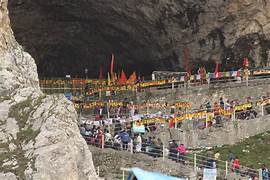
Amarnath Yatra Commences; First Batch Departs from Base Camps Under Tight Security

 :
| Updated On: 03-Jul-2025 @ 2:42 pm
:
| Updated On: 03-Jul-2025 @ 2:42 pmSHARE
The annual Amarnath Yatra began on Thursday with the first batches of pilgrims setting off from the twin base camps at Baltal and Nunwan, embarking on a spiritual journey to the 3,880-metre-high cave shrine nestled in the Himalayas of South Kashmir. This revered shrine, located in the Anantnag district, is famous for housing a naturally formed ice-lingam symbolizing Lord Shiva, attracting lakhs of devotees each year.
According to officials, the yatra commenced early in the morning from two traditional routes: the 48-km Nunwan-Pahalgam track and the shorter 14-km Baltal route. The pilgrims — comprising men, women, and sadhus — began their trek from the Nunwan base camp in Pahalgam, South Kashmir, and from the Baltal base camp in the Sonamarg area of Central Kashmir’s Ganderbal district. As the devotees set off on their journey, chants of "Bum Bum Bhole" echoed through the mountains, creating an atmosphere of devotion and enthusiasm. Senior officials from both camps flagged off the batches of pilgrims in a ceremonial send-off.
The Yatra’s logistical preparations began a day earlier. On Wednesday, Lieutenant Governor Manoj Sinha officially flagged off the first batch of 5,892 pilgrims from the Bhagwati Nagar base camp in Jammu. This marked the formal beginning of this year's pilgrimage season. The pilgrims arrived in the Kashmir Valley later that afternoon, where they were warmly welcomed by both the local administration and the residents, showcasing the cultural and spiritual importance of the pilgrimage in the region.
Once at the shrine, the pilgrims will offer prayers and pay obeisance to the ice-lingam, believed to form naturally every year during the summer in the cold cave environment. The Amarnath Yatra is considered one of the most significant Hindu pilgrimages in India, not only for its religious value but also for the challenging trek it involves through mountainous and often harsh terrain.
Given the high number of participants and the sensitivity of the region, the government has put in place stringent security measures to ensure the safety of the pilgrims. Thousands of personnel from various forces — including the Jammu and Kashmir Police, Central Reserve Police Force (CRPF), Indo-Tibetan Border Police (ITBP), and other paramilitary units — have been deployed across the route. These forces are tasked with managing crowd control, ensuring security at camps, and responding to emergencies.
Additionally, aerial surveillance is being carried out to monitor the entire route and quickly identify any potential security threats or logistical issues. This multi-layered security setup is designed to allow the pilgrimage to proceed smoothly and peacefully, minimizing risks from any external or environmental threats.
The annual yatra typically lasts several weeks and concludes with the Shravan Purnima (Raksha Bandhan), which marks the end of the pilgrimage season. With strong administrative coordination, security arrangements, and the support of local communities, the 2024 Amarnath Yatra has commenced on a hopeful and spiritually uplifting note.